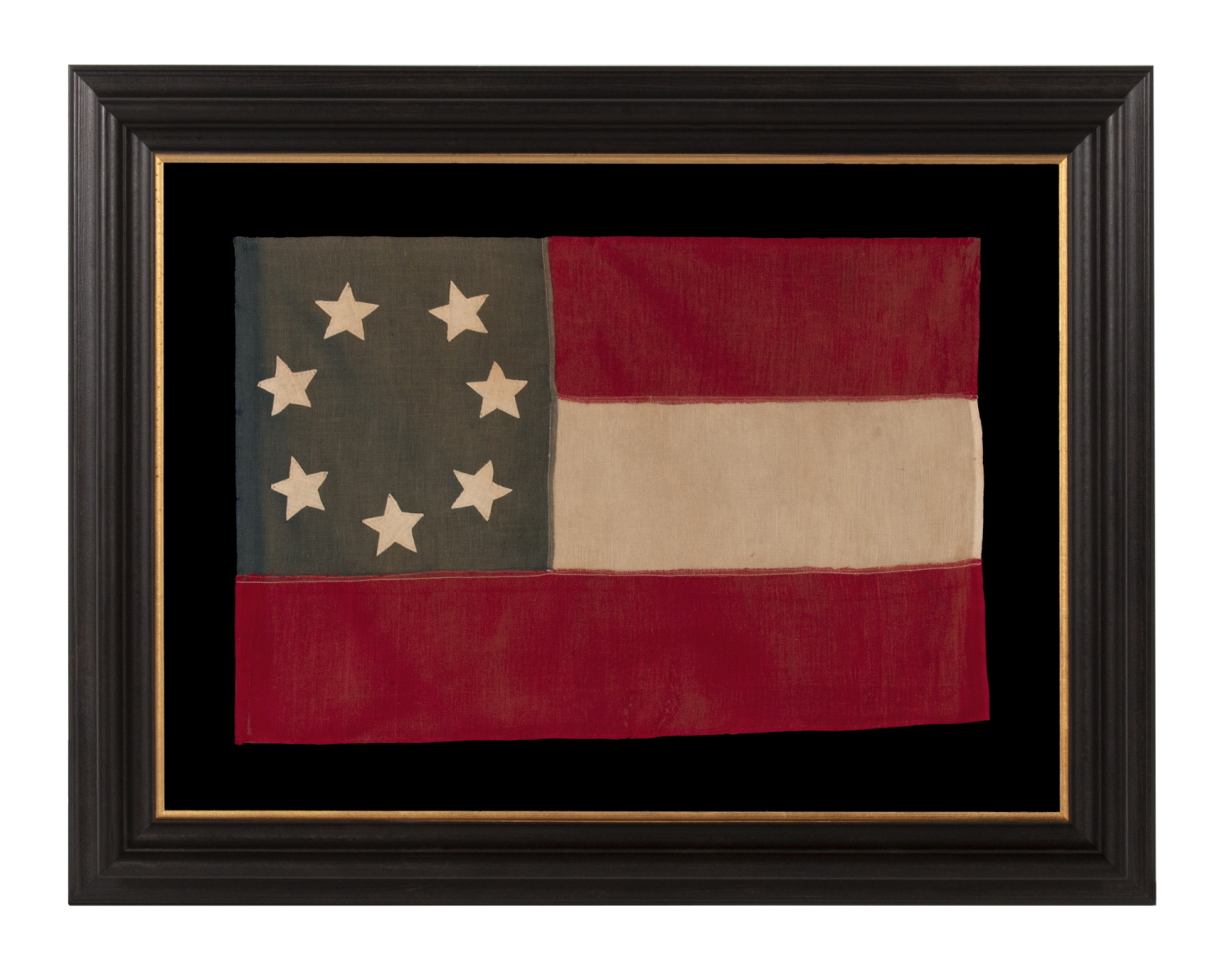
| |
FIRST NATIONAL PATTERN CONFEDERATE FLAG (a.k.a., STARS & BARS) OF THE REUNION ERA, IN THE ORIGINAL, OFFICIAL DESIGN, WITH A CIRCULAR WREATH OF 7 STARS, MADE ca 1890-1910 |
|
| Available: |
Sold |
| Frame Size (H x L): |
27.5" x 35" |
| Flag Size (H x L): |
16.75" x 24" |
|
| Description....: |
|
Confederate flag in the First National design, with 7 stars arranged in a circular wreath. This was the first of three official designs, adopted by the Confederate Congress on March 4th, 1861, when in session at the temporary capitol of Montgomery, Alabama. The count of 7 stars reflects the initial wave of secession, which occurred approximately one month prior, on February 7th, in conjunction with the adoption of a provisional constitution. As more states seceded, more stars were added, with a total of 11 officially seceding by way of some manner of popular vote, ratified, in most instances, by the respective state legislatures. The States of Missouri and Kentucky were also sometimes included, for a total of 13. The later were accepted by Confederate President Jefferson Davis, despite their being Border States with divided views and less formal achievement of secession.
The First National is the flag also known as the "Stars & Bars." Because they were so alike, use of the Stars & Stripes and the Stars & Bars on the same, smoke-laden battlefields created great confusion. For this reason, the Second National Confederate flag was adopted on May 26th, 1863. This had a completely white field, with the Southern Cross (a.k.a., the Confederate battle flag) serving as its canton. Soldiers and officers disliked this design because it looked too much like a surrender flag, and if given the opportunity, would dip the end in blood to provide color.
36 days before the war’s end, a vertical red bar was added along the fly to create the Third National design. This was known as the “blood-stained banner,” though officially paid homage to France, which lent aid to the South during the war. Note how if you were to replace the first third of the flag with a blue vertical bar, the result would be the French tricolor (the national flag of France).
The most commonly recognized flag of the Confederacy, often called the “Southern Cross,” “the Confederate battle flag,” or the "Flag of the Army of Northern Virginia," was put to use in the fall of 1861 and carried by various Confederate units for the remainder of the war. This was a better signal, being distinctly different from the Stars & Stripes.
Many people are surprised to learn that the Southern Cross was not the national flag of the Confederate States of America. Officially, in rectangular format, it served as the Confederate Navy Jack, flown when a ship was at port or anchor. In either square or rectangular format, it was carried by land forces as a battle flag, and was assigned that generic title partly because it was so often employed in that function by both Robert E. Lee's Army of Northern Virginia, he armies of P.G.T. Beauregard, and others. It also received widespread love in the South because the Second and Third National designs were not particularly admired by Confederate soldiers, the Second for reasons previously stated and the Third because the design was so short-lived.
Construction: This is a homemade flag. The stars are made of plain weave cotton and are hand-sewn. The canton and bars are made of gauze-like cotton bunting that has been pieced and joined with machine stitching.
Mounting: The flag was mounted and framed within our own conservation department, which is led by expert staff. We take great care in the mounting and preservation of flags and have framed thousands of examples.
The background is 100% cotton twill, black in color. The mount was placed in a black-painted, Italian molding with a shaped profile and a silver inner lip. The glazing is U.V. protective plexiglass.
Condition: The canton has faded, due to both exposure and a fugitive dye. There are tack holes along the hoist end, where the flag was once affixed to a wooden staff. There are losses in the upper, fly end corner, in the top red bar, from extended use, and there are two vertical tears in the bottom red bar, near the center, with minor associated loss. a few tiny holes in the canton. Fabric of similar coloration was placed behind the flag during the mounting process. Many of my clients prefer early flags to show their age and history of use. |
|
|
|
| Collector Level: |
Intermediate-Level Collectors and Special Gifts |
|
| Flag Type: |
Sewn flag |
|
| Star Count: |
07 |
|
| Earliest Date of Origin: |
16.75" x 24" |
|
| Latest Date of Origin: |
27.5" x 35" |
|
| State/Affiliation: |
The Confederacy |
|
| War Association: |
1861-1865 Civil War |
|
| Price: |
SOLD |
|
| |
Views: 1166 |
|
|
|

